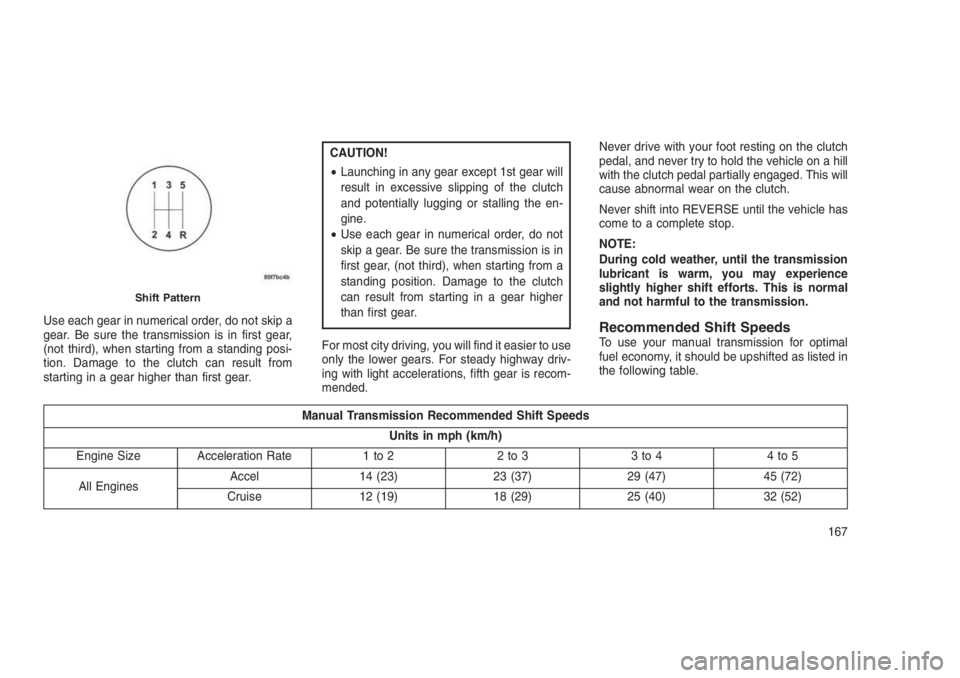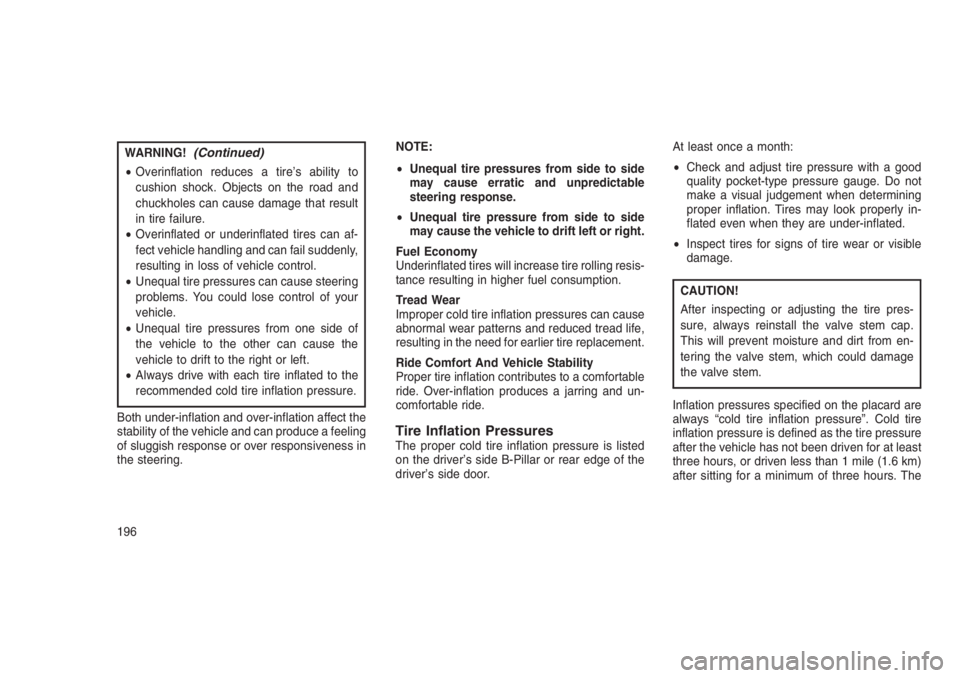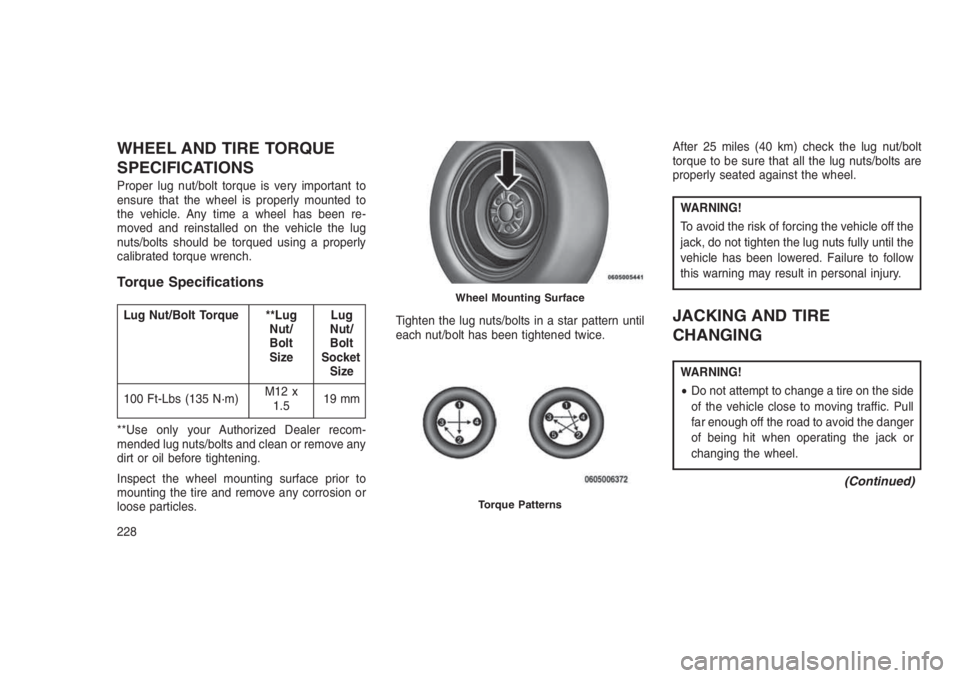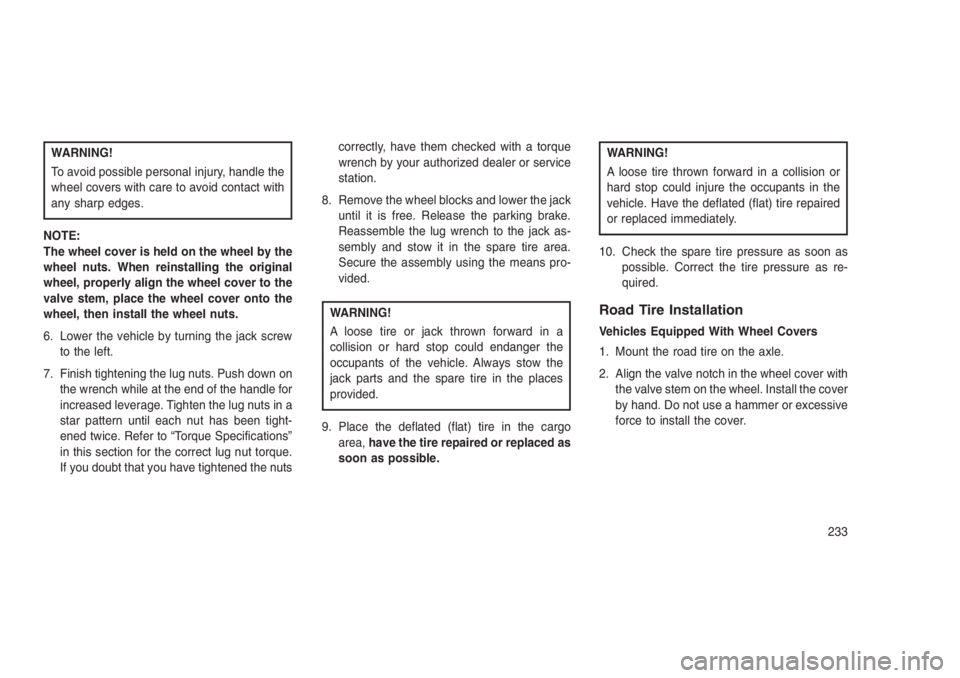lug pattern JEEP PATRIOT 2020 Owner handbook (in English)
[x] Cancel search | Manufacturer: JEEP, Model Year: 2020, Model line: PATRIOT, Model: JEEP PATRIOT 2020Pages: 332, PDF Size: 1.99 MB
Page 171 of 332

Use each gear in numerical order, do not skip a
gear. Be sure the transmission is in first gear,
(not third), when starting from a standing posi-
tion. Damage to the clutch can result from
starting in a gear higher than first gear.
CAUTION!
•Launching in any gear except 1st gear will
result in excessive slipping of the clutch
and potentially lugging or stalling the en-
gine.
•Use each gear in numerical order, do not
skip a gear. Be sure the transmission is in
first gear, (not third), when starting from a
standing position. Damage to the clutch
can result from starting in a gear higher
than first gear.
For most city driving, you will find it easier to use
only the lower gears. For steady highway driv-
ing with light accelerations, fifth gear is recom-
mended.Never drive with your foot resting on the clutch
pedal, and never try to hold the vehicle on a hill
with the clutch pedal partially engaged. This will
cause abnormal wear on the clutch.
Never shift into REVERSE until the vehicle has
come to a complete stop.
NOTE:
During cold weather, until the transmission
lubricant is warm, you may experience
slightly higher shift efforts. This is normal
and not harmful to the transmission.
Recommended Shift SpeedsTo use your manual transmission for optimal
fuel economy, it should be upshifted as listed in
the following table.
Manual Transmission Recommended Shift Speeds
Units in mph (km/h)
Engine Size Acceleration Rate 1 to 2 2 to 3 3 to 4 4 to 5
All EnginesAccel 14 (23) 23 (37) 29 (47) 45 (72)
Cruise 12 (19) 18 (29) 25 (40) 32 (52)
Shift Pattern
167
Page 200 of 332

WARNING!(Continued)
•Overinflation reduces a tire’s ability to
cushion shock. Objects on the road and
chuckholes can cause damage that result
in tire failure.
•Overinflated or underinflated tires can af-
fect vehicle handling and can fail suddenly,
resulting in loss of vehicle control.
•Unequal tire pressures can cause steering
problems. You could lose control of your
vehicle.
•Unequal tire pressures from one side of
the vehicle to the other can cause the
vehicle to drift to the right or left.
•Always drive with each tire inflated to the
recommended cold tire inflation pressure.
Both under-inflation and over-inflation affect the
stability of the vehicle and can produce a feeling
of sluggish response or over responsiveness in
the steering.NOTE:
•Unequal tire pressures from side to side
may cause erratic and unpredictable
steering response.
•Unequal tire pressure from side to side
may cause the vehicle to drift left or right.
Fuel Economy
Underinflated tires will increase tire rolling resis-
tance resulting in higher fuel consumption.
Tread Wear
Improper cold tire inflation pressures can cause
abnormal wear patterns and reduced tread life,
resulting in the need for earlier tire replacement.
Ride Comfort And Vehicle Stability
Proper tire inflation contributes to a comfortable
ride. Over-inflation produces a jarring and un-
comfortable ride.
Tire Inflation PressuresThe proper cold tire inflation pressure is listed
on the driver’s side B-Pillar or rear edge of the
driver’s side door.At least once a month:
•Check and adjust tire pressure with a good
quality pocket-type pressure gauge. Do not
make a visual judgement when determining
proper inflation. Tires may look properly in-
flated even when they are under-inflated.
•Inspect tires for signs of tire wear or visible
damage.
CAUTION!
After inspecting or adjusting the tire pres-
sure, always reinstall the valve stem cap.
This will prevent moisture and dirt from en-
tering the valve stem, which could damage
the valve stem.
Inflation pressures specified on the placard are
always “cold tire inflation pressure”. Cold tire
inflation pressure is defined as the tire pressure
after the vehicle has not been driven for at least
three hours, or driven less than 1 mile (1.6 km)
after sitting for a minimum of three hours. The
196
Page 232 of 332

WHEEL AND TIRE TORQUE
SPECIFICATIONS
Proper lug nut/bolt torque is very important to
ensure that the wheel is properly mounted to
the vehicle. Any time a wheel has been re-
moved and reinstalled on the vehicle the lug
nuts/bolts should be torqued using a properly
calibrated torque wrench.
Torque Specifications
Lug Nut/Bolt Torque **Lug
Nut/
Bolt
SizeLug
Nut/
Bolt
Socket
Size
100 Ft-Lbs (135 N·m)M12 x
1.519 mm
**Use only your Authorized Dealer recom-
mended lug nuts/bolts and clean or remove any
dirt or oil before tightening.
Inspect the wheel mounting surface prior to
mounting the tire and remove any corrosion or
loose particles.Tighten the lug nuts/bolts in a star pattern until
each nut/bolt has been tightened twice.After 25 miles (40 km) check the lug nut/bolt
torque to be sure that all the lug nuts/bolts are
properly seated against the wheel.
WARNING!
To avoid the risk of forcing the vehicle off the
jack, do not tighten the lug nuts fully until the
vehicle has been lowered. Failure to follow
this warning may result in personal injury.
JACKING AND TIRE
CHANGING
WARNING!
•Do not attempt to change a tire on the side
of the vehicle close to moving traffic. Pull
far enough off the road to avoid the danger
of being hit when operating the jack or
changing the wheel.
(Continued)
Wheel Mounting Surface
Torque Patterns
228
Page 237 of 332

WARNING!
To avoid possible personal injury, handle the
wheel covers with care to avoid contact with
any sharp edges.
NOTE:
The wheel cover is held on the wheel by the
wheel nuts. When reinstalling the original
wheel, properly align the wheel cover to the
valve stem, place the wheel cover onto the
wheel, then install the wheel nuts.
6. Lower the vehicle by turning the jack screw
to the left.
7. Finish tightening the lug nuts. Push down on
the wrench while at the end of the handle for
increased leverage. Tighten the lug nuts in a
star pattern until each nut has been tight-
ened twice. Refer to “Torque Specifications”
in this section for the correct lug nut torque.
If you doubt that you have tightened the nutscorrectly, have them checked with a torque
wrench by your authorized dealer or service
station.
8. Remove the wheel blocks and lower the jack
until it is free. Release the parking brake.
Reassemble the lug wrench to the jack as-
sembly and stow it in the spare tire area.
Secure the assembly using the means pro-
vided.
WARNING!
A loose tire or jack thrown forward in a
collision or hard stop could endanger the
occupants of the vehicle. Always stow the
jack parts and the spare tire in the places
provided.
9. Place the deflated (flat) tire in the cargo
area,have the tire repaired or replaced as
soon as possible.
WARNING!
A loose tire thrown forward in a collision or
hard stop could injure the occupants in the
vehicle. Have the deflated (flat) tire repaired
or replaced immediately.
10. Check the spare tire pressure as soon as
possible. Correct the tire pressure as re-
quired.
Road Tire Installation
Vehicles Equipped With Wheel Covers
1. Mount the road tire on the axle.
2. Align the valve notch in the wheel cover with
the valve stem on the wheel. Install the cover
by hand. Do not use a hammer or excessive
force to install the cover.
233